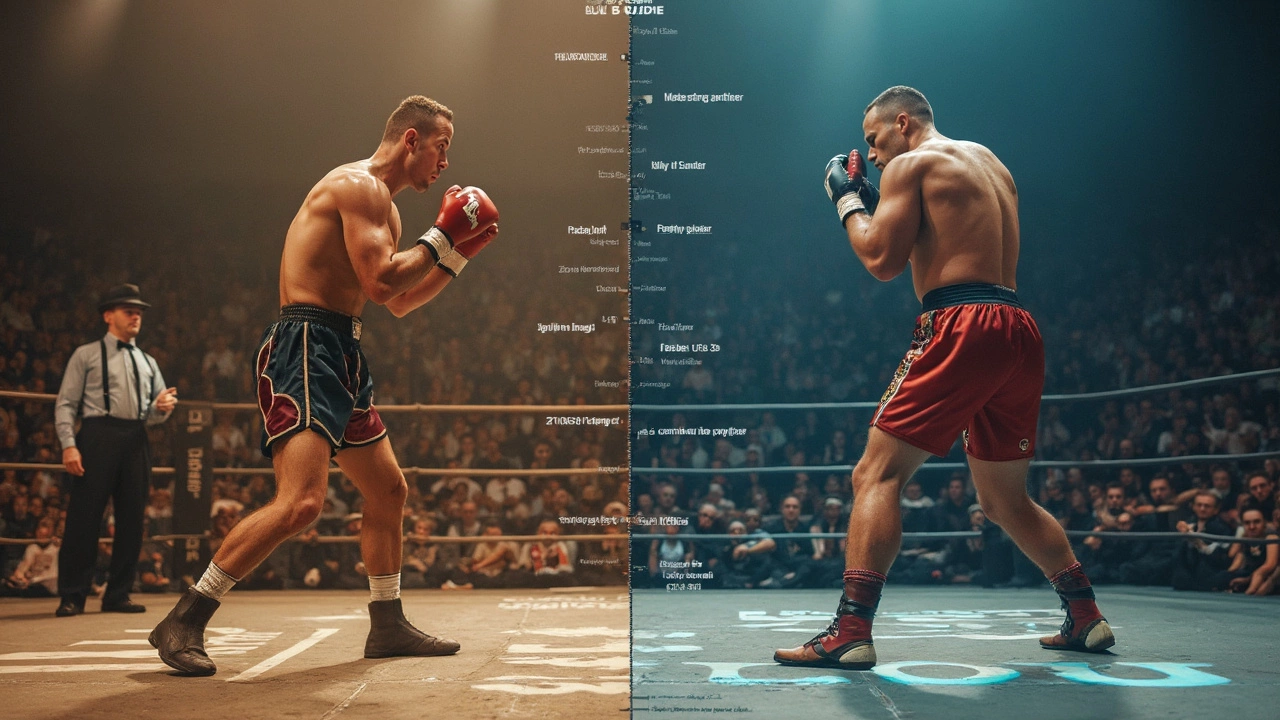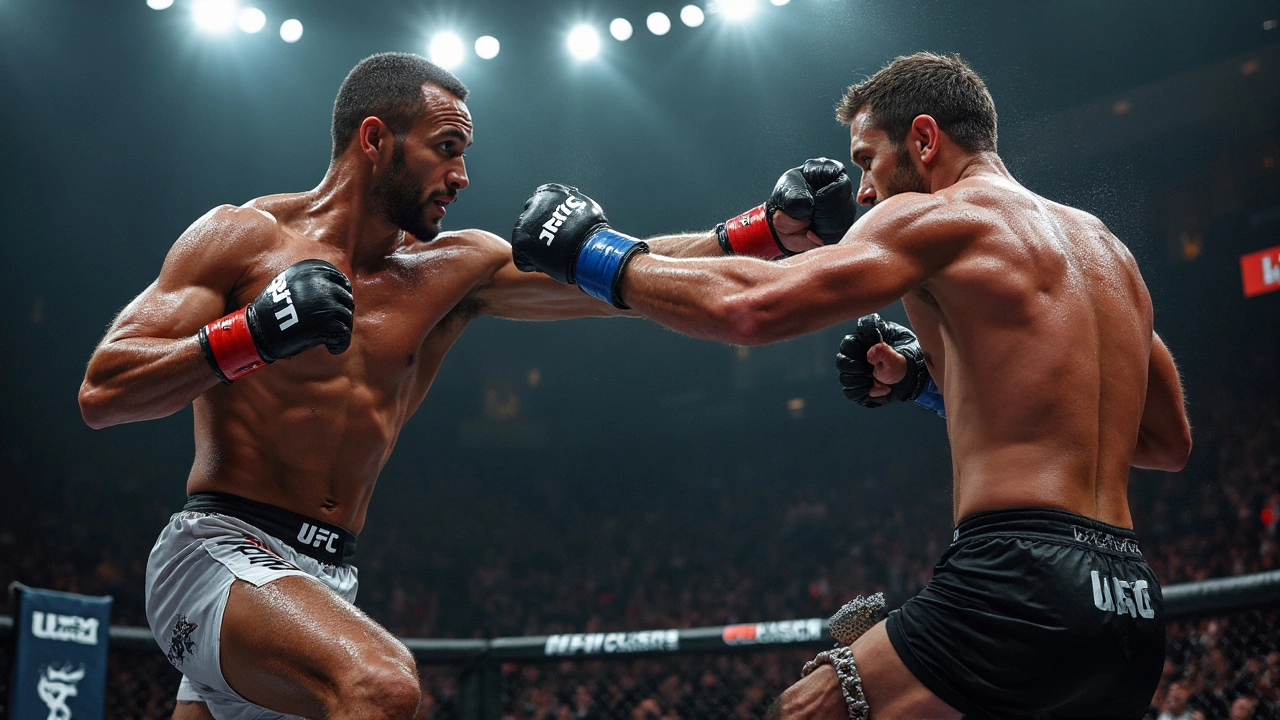Ever wonder why the UFC is often talked about in the same breath as traditional boxing? It's because the UFC, or Ultimate Fighting Championship, has become a major player in the world of combat sports. But don't confuse it with boxing—they're cousins in the same family, but with quite different personalities.
In a nutshell, the UFC is all about mixed martial arts (MMA). Picture a cocktail of striking, grappling, and ground fighting—not just the classic punches and jabs you see in the ring. This means fighters have a wider arsenal of moves. Ever thought of kicking as part of a boxing match? In UFC, that's totally legit!
But why is it called UFC, you ask? Well, it's actually the name of a company that organizes and promotes these MMA events. The name has become synonymous with the sport itself. It's like calling all facial tissues 'Kleenex'—the brand is that iconic.
- The Origins of UFC
- UFC vs Traditional Boxing
- Rules and Regulations of UFC
- Tips for Watching a UFC Match
The Origins of UFC
The UFC wasn't always the giant it is today. If we take a little trip back to 1993, you'll find the UFC's first event, which was more of an experiment than the shows we see now. The founders, Art Davie and Rorion Gracie, were curious. They wanted to see which martial art style was the best. So, they organized a tournament where fighters with various backgrounds would face off in a no-holds-barred contest.
The first event took place in Denver, Colorado, and it was raw, to say the least. Back then, the rules were scarce, and it wasn’t uncommon to see hair-pulling, groin shots, and even fewer restrictions on what fighters could do. Today, you'd probably gasp, but that's what gave the event its initial shock value and set the stage for evolution.
MMA had been around for ages, but the UFC helped shape it into a more recognized sport. With the legendary Royce Gracie demonstrating the effectiveness of Brazilian Jiu-Jitsu by using technique over brute strength, folks started to see the value in a mixed set of skills rather than just focusing on one discipline.
The Evolution
The sport didn't become mainstream overnight. It faced tons of criticism for being too violent, leading to political intervention. Pay-per-views were hard to secure, and it almost went bankrupt. But things took a turn when Dana White and the Fertitta brothers purchased the UFC in 2001. They revamped it with better rules and more marketable events.
Fast-forward to today, and the UFC is a global phenomenon. It's grown more sophisticated, with a clear set of rules, weight classes, and athletic commissions overseeing fights. It's not just about brutality anymore; it's about strategy, skill, and overcoming challenges.
UFC vs Traditional Boxing
Trying to figure out the differences between UFC and traditional boxing is a bit like comparing apples to oranges—both are sports, sure, but they offer different flavors.
The Evolution of Combat
First off, let’s talk about the spectrum of fighting styles. Traditional boxing, as you know, is all about punches, focusing on techniques like jabs, hooks, and uppercuts. The fighters stay on their feet, with the objective being to outscore the opponent or knock them out cold.
In contrast, a UFC match is a whole different beast. It incorporates mixed martial arts, meaning fighters can use everything from Brazilian jiu-jitsu to Muay Thai. They strike, they grapple, and they wrestle—there’s more room for agility and creativity in tactics.
Rules and Boundaries
Then there's the setting itself. Boxing happens in a square ring, complete with ropes. Matches go up to 12 rounds, each lasting 3 minutes. In UFC, fighters enter an octagonal cage known as 'The Octagon.' They go for a maximum of 5 rounds, with each round set at 5 minutes, keeping the action tight and intense.
Another key difference lies in the outcome. A boxing match can end with a KO, a technical knockout (TKO), or by decision from judges. In UFC, you've got options like tap outs and submissions in addition to KOs and TKOs, opening the door for diverse strategies to win.
| Feature | Boxing | UFC |
|---|---|---|
| Rounds | Up to 12 x 3 mins | Up to 5 x 5 mins |
| Outcome | KO, TKO, Decision | KO, TKO, Submission, Decision |
| Fighting Styles | Boxing only | MMA - Mixed Styles |
Popularity and Reach
Now, onto impact. Boxing has been around longer and has its own legends, from Muhammad Ali to Mike Tyson. But the UFC is making waves fast. It’s capturing a younger audience, many of whom are glued to events via streaming services and social media platforms. Who doesn’t love a good viral knockout clip?
In conclusion, while both involve intense fist-fighting action, what sets them apart is the variety of tactics and settings. So whether you’re a fan of the classics or all about that MMA action, both have plenty of punches to offer.

Rules and Regulations of UFC
When it comes to understanding the chaos and excitement inside the UFC octagon, knowing the rules is a must. So, what exactly sets a UFC match apart, and how is it different from the straight-up nature of boxing matches?
Weight Classes
First up, fighters are divided into weight classes. This ensures that each fighter is taking on someone of a similar size and weight, keeping things fair and square. From flyweight to heavyweight, each class has its own specific limit.
Round Structure
Unlike boxing's 12-round bonanzas, a standard UFC fight typically consists of three five-minute rounds. Championship bouts can stretch to five rounds. The focus is on energy conservation and strategy.
Legal Techniques
In the diverse world of UFC, fighters can employ a wide array of techniques. While punches and jabs are part of it, kicks, knees, and elbows mix things up. Takedowns and submissions play a key role too. Yet, certain moves like eye-gouging, biting, or headbutts are strictly off-limits.
Judging and Scoring
The scoring system is similar to boxing, using a ten-point must system. Judges score fighters based on factors like striking effectiveness, grappling, control of the fighting area, and overall aggressiveness. It's not just about landing punches; it's about asserting dominance.
Safety Measures
For those concerned about safety, the UFC has rules in place. Protective gear is a must, and referees are trained to stop fights when necessary to protect fighters. Medical staff are always on hand, ready to step in if things get dicey.
Fouls and Penalties
Commit a foul, and you’ll face penalties or disqualification. These include moves like kicks to the head of a grounded opponent or grabbing the fence. These aren’t just for fair play—they’re there to keep the fighters safe.
For a quick look at some foul penalties, here’s a straightforward breakdown:
| Foul | Penalty |
|---|---|
| Low Blow | Warning or point deduction |
| Eye Poke | Point deduction |
| Illegal Knee | Disqualification |
So next time you're watching a UFC fight, keep these rules in mind. It adds a layer of appreciation for the sport, watching fighters not just for their brawn but for their strategy and technique.
Tips for Watching a UFC Match
If you're new to the UFC scene or just want to get more out of the fights, here are some tips to enhance your watching experience. Trust me, understanding the nuances can make any match way more exciting!
1. Know the Fighters
One of the best ways to dive into a UFC match is to get to know the fighters. Check out their fighting styles, strengths, and recent performances. Are they more about grappling or do they have a killer punch? Knowing a little about their history and styles can set the stage for understanding their strategy in the match.
2. Understand the Rounds
UFC fights are generally structured into three 5-minute rounds—unless you're watching a championship or main event, which have five rounds. Understanding the rhythm of these rounds helps you gauge when a fighter might go all out or conserve energy.
3. Pay Attention to the Commentary
The commentators are not just there for background noise; they often provide valuable insights into what's happening in the octagon. They might explain why a certain move matters or why a fighter might be looking drained. Don't tune them out entirely, especially if you're still learning the ropes of MMA.
4. Watch for Grappling and Ground Game
While striking can be thrilling, a lot of action in MMA unfolds on the ground. Knowing a few basic moves—like what a 'guard' or 'mount' is—will help you understand why the ref isn’t breaking things up. This ain't boxing; being on the ground can be as strategic as a standing hit.
5. Explore the Rules
You're probably used to the idea that fights are won by a knockout or decision, but in UFC, there are submissions too. Know what moves are legal, what might get a fighter penalized, and of course, what can lead to a lightning-fast win.
And finally, keep an eye on the ref. Their signals and decisions can turn a fight around in moments. They keep things fair and safe, making sure both fighters play by the rules.
